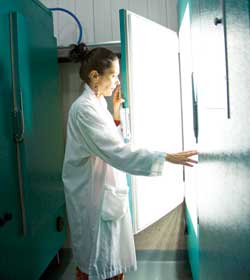Concordia Corner
High tech greenhouse has southwest exposure

Sue Parisella, Biology technician, investigates the seedlings in one of the growth chambers adjacent to the greenhouse on the sixth floor of the Richard J. Renaud Science Complex
Photo by IITS Creative Media Services
Minds are not the only thing growing at Loyola.
Sue Parisella has been a technician with the Biology Department for 25 years. During the last six, she has been responsible for the greenhouse, initially at Sir George, and then for the new facility on the sixth floor of the Loyola Richard J. Renaud Science Complex, which the department now calls home.
The blindingly bright space affords a beautiful southwest view of the island, right to the river. The greenhouse is equipped with multiple controls to manage light, including electronic shades and full spectrum lights available in each of four compartments. Humidity is maintained with windows that close electronically when it rains and water is delivered by slender individual hoses inserted in each plant’s soil. The temperature is also automatically controlled.
Although all of these features offer a manual override, the network is centralized through facilities management at Sir George. The greenhouses serve as laboratories for professors’ research. Luc Varin grows potato and brassica plants, which he uses to explore transgenics, the manipulation of genes intended to produce a specific characteristic. The relationship between particular insects and plants is studied in another compartment.
Parisella herself maintains what she calls her “museum of plants,” a variety of species ranging from ferns to orchids to succulents. Many of these plants are used to demonstrate plant anatomy and physiology in basic biology classes.
Many seedlings and smaller plants are maintained next door to the greenhouse is a series of growth chambers.
These airtight cases can be programmed to simulate various growth conditions across the seasons from arctic to tropical climates. The controlled environments are ideal for young or small plants.
Unfortunately, since this greenhouse is not as high up as the twelfth-floor facilities atop the Hall Building, certain complications were not anticipated. “We had to put netting over the window openings because we had problems with pigeons flying in,” Parisella said.
Varin’s research was temporarily sidetracked when his plants were infested with thrips.
Although the pests can be airborne, they might have been tracked in as well. The problem was brought back under control with a nemotode spray. This biological alternative was used because they do not have a permit to use pesticides.
To prevent insect problems in her compartment, Parisella relies on low-tech sticky paper posted by the plants.
During the academic year about eight other graduate students are able to use the facilities to further their own research in addition to projects undertaken by the faculty.
Parisella is currently growing plants for use in undergraduate general biology labs which begin in early November. One plant, the mimosa, is particularly interesting, “It’s thigmotropic, and essentially faints when you touch it.”
Files from Dawn Wiseman